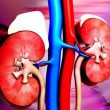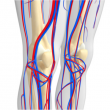At 10-year follow-up, unrecognized or silent MIs have similar mortality to clinically recognized MI and, even though this does not justify routine screening, these findings call for more aggressive prevention. Unrecognized MI, detected by MRI, is associated to long term mortality risk similar to that of recognized MI; therefore, these patients have higher risk...
ESC 2018 | ART: Disappointment with Bilateral Internal-Thoracic Artery Grafts After a 10-Year Follow-Up
Published 5-year results had been neutral for bilateral vs. single internal-thoracic artery grafts, but, at the time, surgeons argued that the time period analyzed was not enough and that a difference would be observed after 10 years of follow-up, once the trial finished. Such follow-up was presented at the European Society of Cardiology (ESC) Congress 2018...
Renal Impairment: How Does It Affect Angioplasty and Surgery?
Courtesy of Dr. Carlos Fava. The incidence of kidney disease is increasing. In its final stage, this pathology is related with coronary disease and increased mortality. Furthermore, we know that, in many occasions, it is associated with diabetes. Nowadays, the evidence comparing the progress of patients with impaired kidney function who have undergone left main...
The Higher the LDL-C Level, the Greater the Benefit in Mortality with Aggressive Therapy
The latest studies seem to support higher baseline LDL-C levels would justify further intensifying and already aggressive drug strategy. A more aggressive hypolipidemic therapy would involve adding far more expensive new drugs that many specialists are reluctant to accept, in terms of their cost benefit ratio. The intensive therapy to lower LDL-C levels reduces cardiovascular...
Peri-Procedural Infarction: More Frequent than and Not as Innocent as We Thought
Almost 30% of all patients experience some degree of myocardial injury after elective angioplasty, a statistic associated to an increase in cardiovascular events at 30 days and 1 year, according to this study recently published in Eur Heart J. The study only included consecutive patients who underwent elective angioplasty with a negative troponin level at admission. The...
Peri-Procedural Infarction: More Frequent than and Not as Innocent as We Thought
Almost 30% of all patients experience some degree of myocardial injury after elective angioplasty, a statistic associated to an increase in cardiovascular events at 30 days and 1 year, according to this study recently published in Eur Heart J. The study only included consecutive patients who underwent elective angioplasty with a negative troponin level at admission. The...
ACC 2018 | Risk of MI in Non-Cardiac Surgeries
One in five patients presenting perioperative MI during non-cardiac surgery should be readmitted within 30 days after surgery, and one in seven dies within the same period, according to the new study presented at ACC 2018 scientific sessions and simultaneously published in Circulation. These infarctions could be considered a iatrogenic complication, given the obvious lack of proper...
What’s New in the European Guidelines on Peripheral Arterial Disease
Since the last version of the European guidelines on the diagnosis and treatment of peripheral arterial disease in 2011, there have been many trials and registries that warrant guideline adjustments in many aspects. The first novelty is the teamwork that gave way to these guidelines, which were written in collaboration with the European Society of...
Lesion Targeting Seems to Be the Secret in Critical Ischemia
Ulcers that do not heal, thus threatening the integrity of a lower limb in patients with critical ischemia, is a main concern. Sometimes, despite successful revascularization, major amputation cannot be prevented. The anatomical description of angiosomes started in the 70s as a way of optimizing tissue grafts. Angiosomes are basically blocks of tissue that include...
The diagnostic performance of the iFR makes the FFR tremble
Despite the evidence, most stable patients continue to be managed based on coronary angiography and, worse, often without a prior non-invasive functional study. With the introduction of the FFR, we left the “anatomical” era for the “functional” era in the catheterization room, which has been proven to improve patients prognosis and, as if that were...








